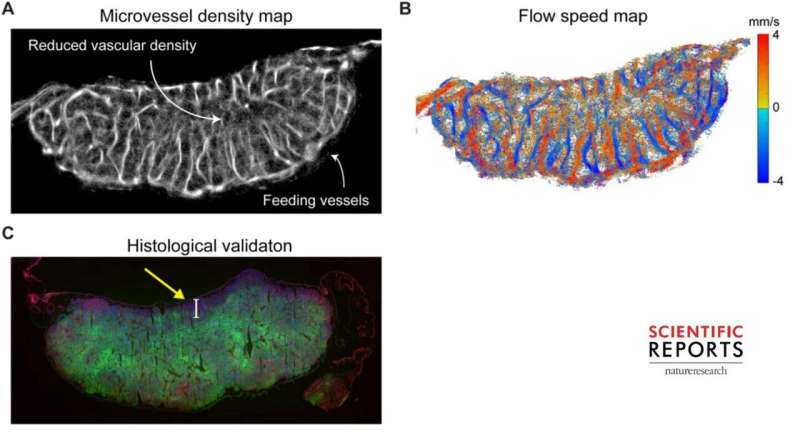Using ultrasound localization microscopy to detect oxygen levels in tissues

Researchers at the University of Illinois at Urbana-Champaign are using a new application of an existing imaging technique that may help detect tumors in humans.
The technique, super-resolution ultrasound localization microscopy, was used to visualize the distribution of blood vessels and measure oxygen levels in tumors. The study was carried out in chicken embryos, but the researchers hope to extend the studies in humans.
The paper "Ultrasound localization microscopy of renal tumor xenografts in chicken embryo is correlated to hypoxia" was published in Scientific Reports.
ULM uses microbubbles, which are the size of red blood cells, to image tissues.
"We track these bubbles as they flow through blood vessels to obtain a higher resolution image than traditional ultrasounds," said Matthew Lowerison, a postdoctoral research associate in the Song Research Group at the Beckman Institute for Advanced Science and Technology.
Researchers have long known that tumors can be resistant to therapy because of their lower oxygen levels. "Red blood cells can flow through straight blood vessels quickly and efficiently. As a result, the delivery of oxygen and nutrients is efficient," Lowerison said. "In contrast, the blood vessels in tumors are twisted onto each other. It is chaotic and disorganized, and the delivery of oxygen is inefficient."
The members of the Song group have used ULM to demonstrate that oxygen levels are lower in tumors compared to healthy tissue.
"This study is unique because we can image tissue that is deeper inside humans without losing image resolution," said Pengfei Song, an assistant professor of electrical and computer engineering and a full-time faculty member at the Beckman Institute. "Although this technique requires us to inject these microbubbles, they do not have toxicity problems as other imaging agents. Additionally, the microbubbles are approved by the Food and Drug Administration and are widely used in clinic around the world."
Currently the main challenge posed by this technique is the acquisition time. "We need to have a large data set to process the images," Lowerison said. "Although as engineers we are focused on getting the best possible images we can, this technique might work for doctors who want a better vascular image than the conventional imaging methods."
"We are starting to see good results when we use artificial intelligence and machine learning with these technologies, which can help to make this process faster," Song said. "Ultimately, we want to be able to use this technique in a clinical setting for cancer detection, diagnosis, and therapy evaluation."
More information: Matthew R. Lowerison et al, Ultrasound localization microscopy of renal tumor xenografts in chicken embryo is correlated to hypoxia, Scientific Reports (2020). DOI: 10.1038/s41598-020-59338-z



















